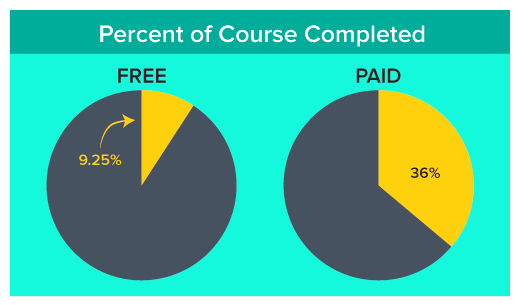So, you’ve made the decision to create an online course and now you are wondering whether you can make any money with it..
Or maybe you’ve started – or even finished – creating your course already.
But, now the question remains: How much are you going to charge? What’s the right price for your course?
This post will walk you through exactly how to price your online course for maximum success.
1. Remember: You’re Selling a Transformation!
Via Kimber Yoga
If the idea of charging for your expertise is intimidating to you, you’re not alone.
But something you should always keep in mind is that you’re not just selling knowledge, you’re selling a transformation (and if you’re not, you should be!).
[click_to_tweet tweet=”Something you should always keep in mind is that you’re not just selling knowledge, you’re selling a transformation (and if you’re not, you should be!).” quote=”Something you should always keep in mind is that you’re not just selling knowledge, you’re selling a transformation (and if you’re not, you should be!).” theme=”style6″]For example:
- How to love your body in 30 days
- How to get your first 5 clients through social media
- Be the confident parent you’ve always wanted to be
Each of these three courses promises a potential transformation – meaning you’re taking your students from a specific BEFORE to a specific AFTER:
- Not loving your body > Loving your body
- Not having clients > Having 5 clients
- Feeling unsure as a parent > Feeling confident as a parent
Once you know the transformation you’re offering, it’s time to move on to the next step, which is…
2. How Much is This Transformation Worth?
This is much easier to price your online course if your transformation involves helping your students make more money.
But, even if you’re simply saving your students time or stress, it’s important to put a price tag on this.
For instance, how much would someone be willing to pay:
- So they could feel more confident?
- To accomplish their goal in 30 days rather than a year?
- In order to get healthy?
- To be able to spend less time working and more time with their family?
Yes, it’s difficult to put a price tag on these transformations.
But the key here is that what you’re teaching matters.
If you’ve created kick butt content that will actually lead to these outcomes, you shouldn’t be charging for those results.
[click_to_tweet tweet=”If you’ve created kick butt content that will actually lead to these outcomes, you shouldn’t be charging for these results.” quote=”If you’ve created kick butt content that will actually lead to these outcomes, you shouldn’t be charging for these results.” theme=”style6″]Which leads us to my next point…
3. In General, Don’t Go Below $99
When you charge less, students tend to undervalue your course content. Graphic via ConvertKit
If you’re used to the Udemy model of online courses, this one may be a little uncomfortable for you (Udemy typically sells all their courses for around $14).
But if you go back to #2, it makes perfect sense.
Is the transformation you’re delivering worth LESS than $99?
No, it’s not…so don’t sell yourself short!
Charging less will likely result in one or even all of these negative consequences:
- Your students won’t take the course seriously, and won’t put in the required time and effort. If you don’t believe me, see the graphic above for the difference in completion rates between a free course and a paid one.
- Your course value will be perceived as lower than a higher-priced course
- You’ll have to get way more students to make the same amount of money
- When you charge too little, you tend to attract buyers who are looking for a deal and who will “nickel and dime” you to death! These buyers are more likely to request refunds and to take up more of your time and energy than those who pay a higher price.
4. How Much Do You Want to Make From Your Course?
This won’t be the be-all-end-all for pricing your course, but it does help put things in perspective.
If your plan is to make most of your income from sales of your online course, how much do you need to make?
Or maybe you’re not thinking of replacing all your service-based income with your course, but just want to make an extra $5-$10K each year from your course.
Keep this in mind: Be realistic in setting your goals. Let’s say your goal is to make an extra $10,000 each year from your course. Your email list is 1,000 people, and you have an engaged Facebook group of 500 members.
While you’ll almost certainly attract some students outside of your email list and Facebook group, count on most of your sales coming from your existing audience.
If you charge $20 for your course, this means you’ll have to sell your course to around 500 people. With a current audience of 1,500, this translates to a 75% conversion rate.
Only you know if this is attainable given your niche, audience and course topic…but, I'm gonna go out on a limb here and say this level of conversion is not realistic.
Now imagine pricing your course at $500. Now, you only have to sell your course to 20 people – this is a much more realistic goal!
5. How Much Do You Need to Charge for Your Online Course to Make A Profit?
Keep in mind that once you’ve created your course, you’ll still need to spend time marketing it, doing customer service, creating updates, etc.
It takes roughly the same amount of effort to market a lower priced course as it does a higher priced course. Think about the time it takes you to get a lead, nuture that lead and walk them through the sales process. It's an investment of a good deal of your time, some money on ad spend and most definitely effort on your part.
Be sure to factor this all in! You need to be able to afford to advertise your course. Not only that, but your profit needs to exceed your ad spend! Check out this visual example from Thinkific:
6. Charge More for Additional Features/Access
While the price of your course shouldn’t be directly tied to the length of your course, the more features or bonuses you offer, the more you’ll typically charge.
Here’s a good exercise to get you thinking.
Start with a base price of $100.
Now, depending on what features or bonuses you offer as part of your course, your price will go up. Some of the bonuses you can offer to include:
- Weekly Q&As
- Expert interviews
- Downloadable workbooks
- Video transcriptions
- An online community
Each of these bonuses will mean more work on your part, and more value for your students…so don’t be afraid to factor these into your price!
7. Choose a Pricing Structure For Your Online Course
Once you’ve decided how much you’re going to charge, you have one final step: to choose your pricing structure.
Will you offer a payment plan? This might mean breaking down a $300 course into 3-monthly payments of $100.
Will you offer only one standard course option, or will you offer pricing tiers? Pricing tiers for a course might be a $199 fee for the basic version, $299 for the standard version, and $399 for the premium version.
Each tier would likely offer different amounts of content, live support or community; and even though most students will likely purchase the standard option (it’s just human nature!), they’ll feel more confident in their decision when they see how it compares to the lower and higher-priced options.
Final thoughts
You’ll notice that one popular pricing technique wasn’t included on my list: deciding your price based on what other courses in your niche are going for.
There’s a good reason for this – It really doesn’t matter.
You should be charging based on the value you’re providing and transformation you’re helping your students achieve.
[click_to_tweet tweet=”You should be charging based on the value you’re providing and transformation you’re helping your students achieve.” quote=”You should be charging based on the value you’re providing and transformation you’re helping your students achieve.”]While it doesn’t hurt to see what others in your niche are charging for their online courses (this can be helpful when it comes time to market your course), don’t let yourself be limited by how much others are charging.
After all, you’re offering knowledge and expertise that only YOU can offer!
Now over to you: How much are you going to charge for your course? Are you going with pricing tiers or one set price? Let me know in the comments below!
Other Articles You Might Find Helpful:
The 7 Best Course Platforms Compared (and how to choose the one that's right for you!)
About Author
Kim Garst
Kim Garst is a renowned marketing strategist and speaker who is trailblazing the use of artificial intelligence in digital marketing. With over 30 years of experience as an online entrepreneur, Kim helps entrepreneurs grow their business and authority online by using AI technology. She is leading the way with proven AI frameworks that help entrepreneurs build authority in their space.
She is keynote speaker and an international best-selling author of Will The Real You Please Stand Up, Show Up, Be Authentic and Prosper in Social Media.
Named by Forbes as a Top 10 Social Media Power Influencer, Kim is well-known for her skill to simplify complex technology and make the use of AI understandable for business growth. Her relatable, actionable advice helps guide new entrepreneurs to harness the power of AI to succeed in digital marketing. Kim is leading the way in combining human and technological skills to create a new model for AI-powered marketing.







6 thoughts on “The Complete Guide on How to Price Your Online Course for the Greatest Success”
This is a great article Kim, it’s made me re-think my pricing for my course in planning, Cheers Mick
This is very true. I think a lot of people who offer courses sell themselves short. They forget that they’re providing more than just a course, but a transformation to people’s lives that could be priceless.
I really enjoy reading your posts, Kim! The last two have been especially interesting and timely since I have been creating courses and the question of pricing has been on my mind for some time. I love what you are saying about the relationship between the value and price. One of the doubts I’ve been having is whether my courses are priced too high. I can see how to position and justify the prices now. Very helpful information and inspiring too, thank you! 🙂
Hi Kim, great article. I think u have a typo in your number two tweet quote. It says you Shouldn’t be charging. I think you meant should… anyway great article! Lisa G
This is a great article – step by step – clear. I especially liked this point- When you charge less, students tend to undervalue your course content. So true – I’ve signed up for free courses and they seem to get pushed to the wayside!
Thank you very much. I’m recently working on that, there’s are some little difficulty but after reading your article it makes some more sense how to fix these difficulties.
thanks again.